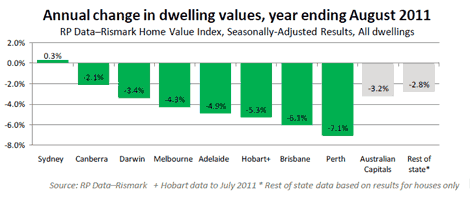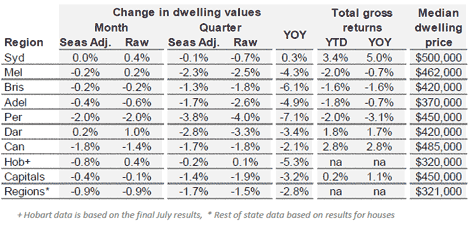Sydney house prices hold steady as national decline slows
Australia’s biggest housing market has shown “noteworthy” resilience by bucking a 0.4% seasonally adjusted national decline in house prices over August, according to the RP Data-Rismark August Hedonic Index.
The 0.4% drop in national prices was the smallest seasonally adjusted decline since April 2011.
On a seasonally adjusted basis Sydney house prices remained unchanged over the month, the only major city not to undergo a house price correction.
Based on raw data, Sydney house prices rose 0.4% for the month.
RP Data senior research analyst Cameron Kusher says the Sydney resilience is one of the more noteworthy findings for August, but is not that surprising as the market fundamentals are strong.
“Sydney prices did not go anywhere for five years. Demand is pretty strong and there is not much supply. These fundamentals are supporting some level of growth," he tells Property Observer.
“Over the last 12 months, Sydney dwelling values have increased by 0.3%. Including rents, Sydney’s total return has been 5% over the past year, and is up 3.4% in the first eight months of 2011.
“Another key finding in August was a change in the Melbourne growth dynamics. In the four months prior to August, Melbourne home values declined by about 1% a month (down 1% seasonally adjusted and down 1.2% raw).
“In August, Melbourne home values actually rose in raw terms by 0.2% and reported a much lower seasonally adjusted decline of just -0.2%. It will be interesting to see whether this trend continues as the spring selling season kicks off,” Kusher says.

Property investors and owners will be buoyed by a 0.2% increase in total returns in August – a combination of capital growth plus income (or rents).
Total returns varied markedly on a city-by-city basis.
While Melbourne (-2%), Perth (-2%), Adelaide (-1.8%) and Brisbane (-1.6%) have all experienced negative total returns over the first eight month of 2011, Sydney (+.4%), Canberra (+2.8%), and Darwin (+1.8%) are all in the black.

Brisbane and Melbourne house prices declined by 0.2% in August, with Canberra registering the biggest monthly decrease of 1.8%.
For the July quarter, Perth is the weakest performing capital city with values down 3.8% on a seasonally adjusted based and down 7.1% year-on-year.
Darwin was the only capital city to record seasonally adjusted house price appreciation over the month – up a marginal 0.2%. It also continues to deliver the strongest rental returns with gross rental yield of 5.3% for houses and 5.8% for units.
Rental returns remain weakest in Melbourne with gross rental yields of 3.7% for houses and 4.3% for units.
According RP Data analysis, the premium sector of the market remains the most volatile.
The most expensive 20% of suburbs have recorded capital value falls of 5.5% over the last year compared with a3.1% capital loss across the broad “middle” market and a 2.9% capital loss among the 20% of most affordable suburbs.
Rismark economist Christopher Joye comments: “For most of 2011 Australian households were expecting to get slammed with two to three additional interest rate hikes on top of the circa two hikes they bore in November last year.
“As a consequence of the US and European sovereign debt ructions, and a bump up in the local unemployment rate, interest rate expectations have swung 180 degrees.”
The financial markets are now pricing in nearly six rate cuts by June next year.
As the most rate sensitive sector of the economy, Joye says the housing market will be the main beneficiary of any rate cut.